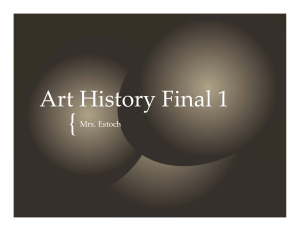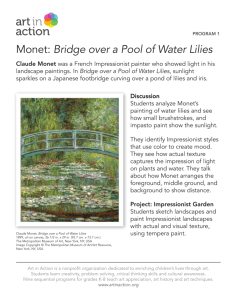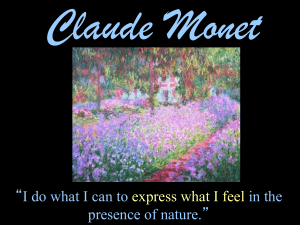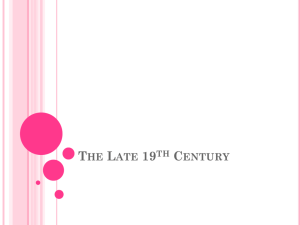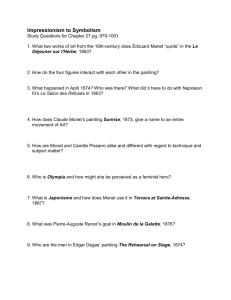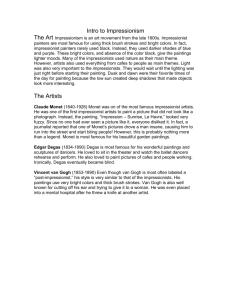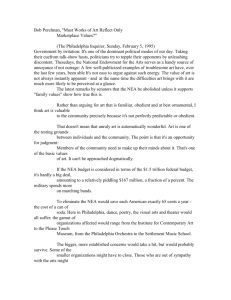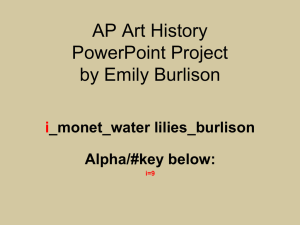French language education kit (English version)
advertisement
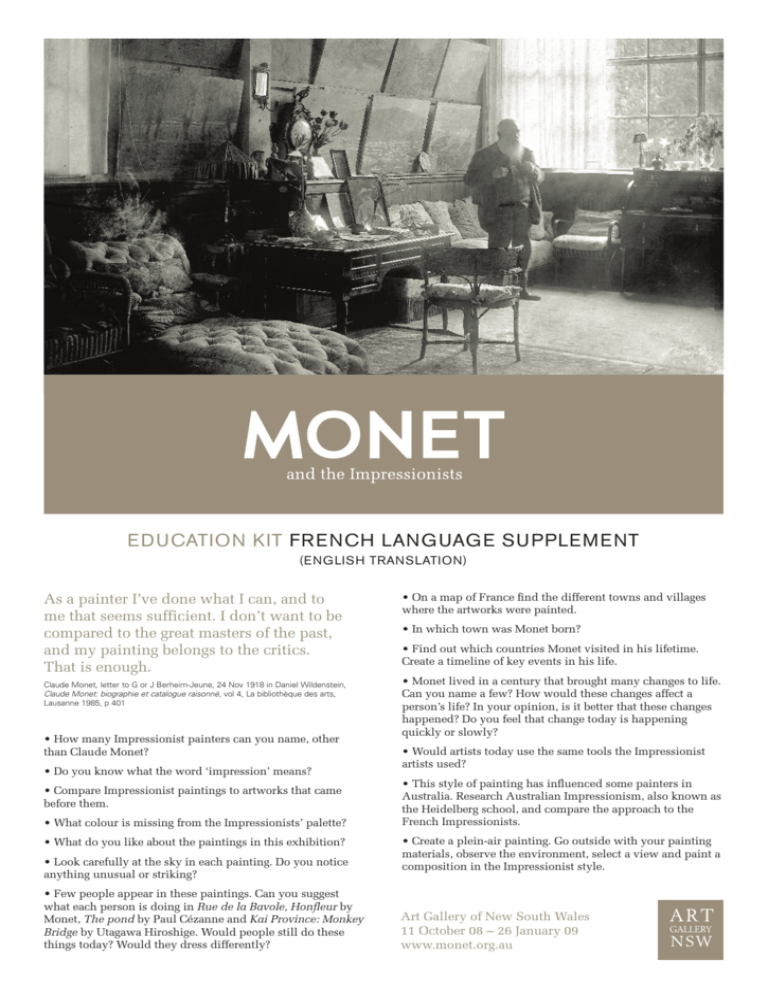
EDUCATION KIT FRENCH LANGUAGE SUPPLEMENT (ENGLISH TRANSLATION) As a painter I’ve done what I can, and to me that seems sufficient. I don’t want to be compared to the great masters of the past, and my painting belongs to the critics. That is enough. Claude Monet, letter to G or J Berheim-Jeune, 24 Nov 1918 in Daniel Wildenstein, Claude Monet: biographie et catalogue raisonné, vol 4, La bibliothèque des arts, Lausanne 1985, p 401 • How many Impressionist painters can you name, other than Claude Monet? • Do you know what the word ‘impression’ means? • Compare Impressionist paintings to artworks that came before them. • What colour is missing from the Impressionists’ palette? • What do you like about the paintings in this exhibition? • Look carefully at the sky in each painting. Do you notice anything unusual or striking? • Few people appear in these paintings. Can you suggest what each person is doing in Rue de la Bavole, Honfleur by Monet, The pond by Paul Cézanne and Kai Province: Monkey Bridge by Utagawa Hiroshige. Would people still do these things today? Would they dress differently? • On a map of France find the different towns and villages where the artworks were painted. • In which town was Monet born? • Find out which countries Monet visited in his lifetime. Create a timeline of key events in his life. • Monet lived in a century that brought many changes to life. Can you name a few? How would these changes affect a person’s life? In your opinion, is it better that these changes happened? Do you feel that change today is happening quickly or slowly? • Would artists today use the same tools the Impressionist artists used? • This style of painting has influenced some painters in Australia. Research Australian Impressionism, also known as the Heidelberg school, and compare the approach to the French Impressionists. • Create a plein-air painting. Go outside with your painting materials, observe the environment, select a view and paint a composition in the Impressionist style. Art Gallery of New South Wales 11 October 08 – 26 January 09 www.monet.org.au AR T Gallery N SW MONET’S EARLY YEARS: SOURCES OF INSPIRATION MONET AND EARLY IMPRESSIONIST Claude Monet Rue de la Bavole, Honfleur c1864 Paul Cézanne The pond c1877–79 oil on canvas, 55.9 x 61 cm Museum of Fine Arts, Boston, bequest of John T Spaulding 48.580 oil on canvas, 47 x 56.2 cm Museum of Fine Arts, Boston, Tompkins Collection – Arthur Gordon Tompkins Fund 48.244 • Does this painting appeal to you? Why or why not? • What do you know about Cézanne? Research the artist and look at examples of his work. • Can you guess the time of day by the shadows cast by the buildings? Give reasons for your choice. • Would there be more people in the street at different times of the day? Give some examples. • Have a close look at what the people in this painting are wearing. Do you think it is summer or winter? • What do you think might be around the corner? Where might the woman in the blue skirt and the child be going? • Where is the town of Honfleur? On what do you base your judgement? Locate this town on a map. • What might you hear if you were the man with the brown jacket? Choose one of the following or imagine the sound yourself: music voices children playing bicycles cars aeroplanes • What might people buy from the shop on the right that has the sign ‘denrées’ (look up the word in a dictionary)? What would a shop like it be called today? • Make up a short dialogue between the man and the woman sitting on the left of the picture talking about the day. • There is a man sleeping under a tree. Why is he tired? Write an account of what happened in his life the day before. • All the men have hats. Why are the women not wearing hats? • Would it be easy for the women to participate in an outdoor activity such as a game of pétanque, towing a boat or fishing? • The picnickers have finished their meal. What do think they have eaten? • If you were having a picnic on the grass today, what would you bring? • The picnickers are beside a pond. What things might they see around them? What might they smell? • Be very quiet, close your eyes and imagine yourself in this scene. What sounds (if any) can you hear? • Draw the inside of the shop. Would it be like a supermarket? Would it be like a country general store? Would there be a lot of light? Would there be many people working in the shop? • Imagine a family living inside one of the houses. Draw and label a floor plan showing the rooms in which they live. Monet and the impressionists / AGNSW EDUCATION KIT / FRENCH LANGUAGE SUPPLEMENT (ENGLISH TRANSLATION) MONET AND THE TRIUMPH OF IMPRESSIONISM: THE 1880s MONET AND JAPANESE ART Claude Monet Cap Martin, near Menton 1884 Utagawa Hiroshige I oil on canvas, 67.2 x 81.6 cm Museum of Fine Arts, Boston, Juliana Cheney Edwards Collection 25.128 Publisher: Koshimuraya Heisuke Kai Province: Monkey Bridge Japan, Edo period, 1853 woodblock print, ink and colour on paper, 37 x 25.4 cm Museum of Fine Arts, Boston, William Sturgis Bigelow Collection 11.26224 • What do you see first when you look at this painting? • How do you feel when you look at this painting? • What is the first thing you feel when you look at this Japanese woodblock print? • Discuss the techniques Monet has used in this painting, including brushstrokes, contrast, shapes and forms. • Find out about the artist Utagawa Hiroshige I and collect images of his work. • Look at the colours in this painting. What colours has Monet used for the road? How many colours has Monet used to represent white? What atmosphere do the colours create? • How many people can you count on the bridge? Imagine a conversation between two of the people: a child and an adult. • Menton is on the Cote d’Azur. Find out the name of the mountains you can see in the background through the clouds. • Is the air still in this picture or is there a breeze blowing? Would it be warm enough to swim? What clues are there to the temperature? • There are houses along the shore across the water. Imagine you are staying in one of them for a holiday. Write a postcard to your best friend telling him/her about the landscape, the weather and your activities. • Compare Rue de la Bavole, Honfleur to this painting. What has changed in the way Monet paints? How has he conveyed the light in these pictures? Monet and the impressionists / AGNSW EDUCATION KIT / FRENCH LANGUAGE SUPPLEMENT (ENGLISH TRANSLATION) • What kind of trees do you think these are? • Imagine you are walking with your family across this bridge. Who is with you? Does the bridge feel safe? Is anyone afraid of heights? What can you see down below? • Write your own haiku in French about this print. Remember the number of syllables allowed. Use a dictionary or thesaurus to help you find the words you need. • What did Monet like about Japanese prints? Would he have been influenced by any of the techniques/effects? Can you find a painting by Monet in this exhibition where the Japanese influence on his art is obvious? MONET’S SERIES MONET AND IMPRESSIONISM AFTER 1900 Claude Monet Charing Cross Bridge (overcast day) 1900 Edgar Degas Dancer looking at the sole of her right foot 1900–10, cast oil on canvas, 60.6 x 91.5 cm Museum of Fine Arts, Boston, given by Janet Hubbard Stevens in memory of her mother, Janet Watson Hubbard 1978.465 • Where is Charing Cross Bridge? Over which river is it built? What can you see in the background on the right of the painting? Find a photograph of this bridge and the area around it today. What is different between then and now? 1919–21 bronze, cire perdu (lost wax), 48 cm height Art Gallery of New South Wales, bequest of Paul Haefliger 1982 60.1983 • What is the dancer doing? Try to do it too. How long can you stand like the dancer? Time yourself and your friends. • What is your first impression of the bridge and the water? Do you think Monet painted this picture en plein air? Where would he have stood to paint it? • Describe this sculpture to someone who cannot see it. What size is it? What is it made of? What would it feel like if you could touch it? Would it be warm or cold, hard or soft, rough or smooth? • What is the weather like? Did the weather influence the way Monet painted? How? • Do you know how this sculpture was made? Find out the steps required. • Research Monet’s visits to London. Did he go often? How long did he stay? How did he get there? Did he like the city? How did he capture its atmosphere in his paintings? • What music was popular at the time this sculpture was made? Listen to some examples. In a group, choreograph a dance to a piece of music you have selected. • Imagine you are Monet and write a letter to one of your Impressionist friends to describe how you feel about London, the river, the light and the weather. • Find photographs of dancers today and compare them to this sculpture. What is different and what is the same? Describe the way each dancer looks. • Monet’s philosophy of painting was to paint what you really see, not what you think you ought to see. How true was he to this philosophy in painting Charing Cross Bridge? • Why are Degas and Monet both called Impressionists? What do they have in common? Find examples in the exhibition to support your argument. Cover: Monet in his house at Giverny. Private collection. Photograph RogerViollet, Paris/The Bridgeman Art Library All photographs of works © Museum of Fine Arts, Boston, except Dancer looking at the sole of her right foot © Art Gallery of NSW, photo by Tim Marshall Monet and the impressionists / AGNSW EDUCATION KIT / FRENCH LANGUAGE SUPPLEMENT (ENGLISH TRANSLATION) ACKNOWLEDGEMENTS This French language supplement has been a collaborative project between the Curriculum K–12 Directorate NSW Department of Education and the Art Gallery of New South Wales. French language activities written by Marie Ange Lewis, French language consultant, Curriculum K–12 Directorate
